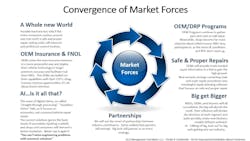Those of you who have followed my musings over the years will know that I have predicted the onset of the connected vehicle, and its impact on the claims workflow. I have also expressed my view that the OEMs, who had been dormant in the industry, would have a significant say in the future claim process.
I think it’s reasonable to say that both of these perspectives are beginning to come to fruition.
I now believe that we are at a critical junction in our industry, that the roads we take in the next two years will go a long way in determining the next 20 years of collision repair and auto claims process and workflow.
I wanted to share my thinking on the strategic imperatives and near-term dynamics that will impact us all going forward.
I have chosen not to focus on a couple of current issues that certainly are front and center. One being the drastic people shortage facing shops, and the supply chain challenges that are causing disruptions to production in a way we’ve never experienced. These issues are very real, but I believe we will find staff, just not where and how we are currently looking, and I’ll leave that to folks far better informed in human resource practices than I am.
As for the second issue, trust me, the parts manufacturers want to sell you parts. As soon as they figure out how to resolve the supply chain challenges in the world of COVID, the parts will be readily available once again. They might be a little more costly than we are used to, but that’s been coming for some time.
Instead, I want to focus here on major structural changes taking shape in our industry. These are changes that are often determined by the strategic decisions of those that sit in high offices at automakers, insurance companies, MSOs and supply chain vendors. These changes are being driven by market behavior and technology advances.
I believe the die is cast for each of these component parts. There is no timeline. It’s a “convergence” of market forces.
All of the following will have significant impact on each industry constituent in the next two years.
- OEM and direct repair programs: The slow death of DRP as we know it is upon us because the economics and metrics are no longer sustainable for most shops. At the same time, the realization of return on investment from OEM certified programs will begin to take effect through more included procedures and, ultimately, vehicle referrals.
- Safe and proper repairs: A safe and proper repair becomes the “true north” of the industry, and with that comes the need for the OEMs to provide critical repair data in user-friendly formats. Technology solves the problem.
- The big get bigger: Consolidation of the entire industry continues unabated. Expect all the big to get bigger in each segment, from insurers, to MSOs, to the supply chain.
- Partnerships: Technology is enabling partnerships unlike anything we’ve seen to date, and you can expect partnerships even between unlikely bedfellows.
- Artificial intelligence: Is it really all that? “You can’t solve engineering problems with economic solutions,” and the current crop of AI is focused on an economic solution.
- OEM insurance and first notice of loss: The OEMs are no longer tip-toeing into auto insurance. They are at full steam ahead. Once they figure out that telematics, and connected vehicles create a far more accurate and consumer beneficial FNOL process, it will follow quickly.
- A whole new world? I hope so. I genuinely believe there is a harmonious claims experience to be had if we focus on customer service and experience, drop the focus on economics, price correctly, and put the customer first.
I look forward to expanding on each of these strategic imperatives in more detail in future articles and to bringing you evidence of the changes identified.
Sean Carey is the president of SCG Management Consultants LLC, a consulting firm working with all sectors of the collision repair and automotive claims industry. He can be reached at [email protected].
About the Author
Sean Carey
Sean Carey is the president of SCG Management Consultants LLC, a consulting firm working with all sectors of the collision repair and automotive claims industry. He can be reached at [email protected].
